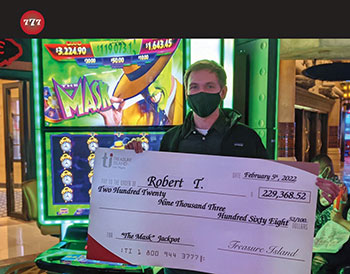Malfunction Pays
For once, a slot computer malfunction works out for a player
By Frank Legato
 “Malfunction voids all plays.”
“Malfunction voids all plays.”
For as long as anyone can remember, those words have been displayed on the front of every mechanical slot machine or at the bottom of the screen of every video slot machine. For the nearly 40 years that slot machines have been electronic—that is to say, self-contained computers— those words have referred to a computer malfunction, and normally, that spelled bad news for the player.
You see, ever since the dawn of microprocessor-controlled slot machines in the early 1980s, each game’s actual reels—or video reels— have played no part in determining the outcome of any given spin. Outcomes are determined by the computer in what is known as the “virtual reel” system.
In this system, the reels themselves serve only as a means of displaying each spin’s results. In the virtual reel system, each slot game’s programming is made up of a group of numbers. It is through duplication within the series of numbers that mathematicians are able to predict a theoretical payback percentage.
Programmers assign numbers to each possible reel outcome. Jackpot symbols and other high- paying symbols receive only one or a few numbers in the program. Low-paying symbols and blanks receive many numbers.
The computer’s random number generator program cycles through all numbers in the program continuously, at speeds of 1,000 numbers per second or faster. When the player hits the “spin” button or pulls the handle, the computer freezes the sequence of numbers generated by the RNG at that nanosecond. The computer instantly translates that sequence into a reel result, and the reels display that result.
Four decades of case law in civil lawsuits have clearly established that the true, legal result of each spin on a slot machine is the result the computer has arrived at in the above sequence— and not necessarily what is displayed on the reels or screen. Almost all of these legal precedents have involved civil lawsuits by players against casinos, claiming winnings to which they thought they were entitled.
Typical of these cases is a malfunction that incorrectly displays that a jackpot has been won. The screen will congratulate the player on, say, a $250,000 jackpot. Often these amounts are more than any jackpot in the slot machine’s pay schedule.
All such big jackpots must be verified by a slot attendant after the machine locks up for a hand pay. The genesis of most of those lawsuits has come when an attendant checks the slot machine’s computer to find that the RNG program arrived at a result other than what was displayed, due to a computer malfunction. Payment denied, lawsuit filed.
And consistently, lawsuit lost.
“Malfunction voids all plays.”
Judges have always found for the casino in these cases, holding that the computer result rules, regardless of what is on the screen. In many of the cases, casinos have paid the players at least a portion of what they claimed they had won, as a gesture of goodwill—and good PR. But we’ve seen many cases where the amount displayed was so outlandish—$250,000 on a machine with a top $10,000 jackpot, for instance— the player ended up with nothing.
In Las Vegas in late January, a player finally came out on the winning end of a computer malfunction.
It happened at the Treasure Island casino on the Las Vegas Strip. A tourist, later identified as Robert Taylor, left his machine and left the casino after the screen displayed a losing result on the reels. It turns out that was a computer malfunction. The actual result arrived at by the machine’s computer? A $230,000 progressive jackpot.
Nevada regulators were automatically notified of the win detected through a regulatory link to the statewide jackpot. It was a multi-site progressive jackpot, so it could have been at any of several casinos. But because of the screen malfunction, no one claimed the prize. No hosts were sent to congratulate a winner; and at the time, there was no big-check PR photo.
Here’s the truly remarkable part of the story. The Nevada Gaming Control Board oversaw a massive search for the winner of the jackpot. Gaming board members and casino authorities reviewed hours of surveillance footage across numerous properties. Witnesses were interviewed. Electronic purchase records were examined. Even ride-share data from the Nevada Transportation Authority was examined.
Nearly three weeks after the win, authorities were able to identify Taylor as the lucky winner. Predictably, he thought it was some sort of scam at first when he was notified. But the gaming board representatives knew he was at Treasure Island that January day, playing that particular progressive slot. So on January 28, Taylor got his $230,000 jackpot, and on Feb. 5, he was presented with the big-check and PR photo op.
For once, “computer malfunction” voided all losses.
“The Nevada Gaming Control Board is charged with the strict regulation of the gaming industry, the protection of the gaming public, and ensuring that the industry benefits the state of Nevada,” said James Taylor, chief of enforcement for the board, in a press statement after the jackpot was awarded.
Yes, scores of players have been burned after thinking they won big, only to find out that their windfall was a computer malfunction. But here, finally, is a practical example of how the slot malfunction rules can work both ways.
Congratulations, Mr. Taylor. And congratulations to Treasure Island and the Nevada gaming authorities, for a display of integrity that surely surprised many. Well done.


